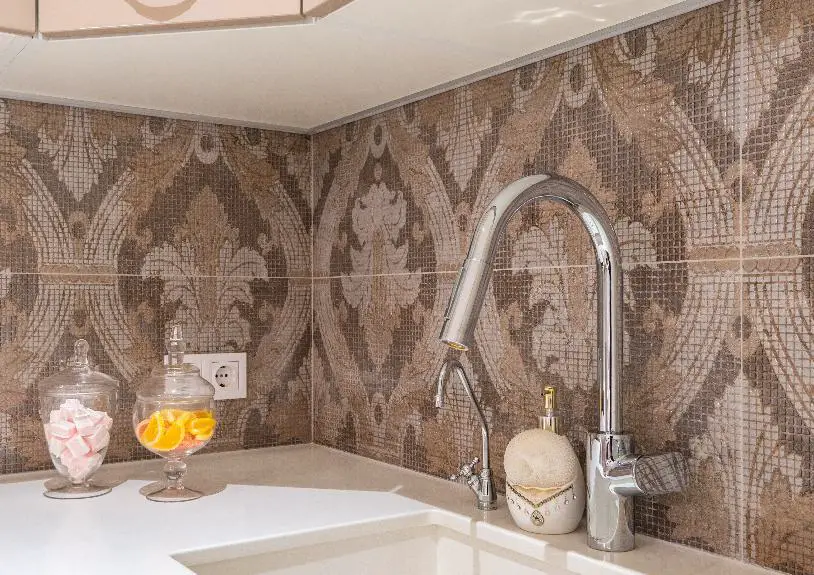The height of a kitchen backsplash is determined by the kitchen's layout, ceiling height, and placement of cabinets and appliances.
A standard backsplash usually reaches the bottom of the upper cabinets. However, personal preference and design trends may lead to different heights.
For example, tiles that extend to the ceiling can give a sense of luxury, while a shorter backsplash might align with a certain feature or fixture.
The choice should consider both the backsplash's protective function and its contribution to the kitchen's design.
Assessing Your Kitchen's Needs
Assessing the needs of your kitchen is essential for determining the right backsplash height. The backsplash, functioning as a protective surface, should match your kitchen's workflow and ease of cleaning. Typically, the standard height is about 600mm, aligning with the bottom of the upper cabinets, providing a tidy endpoint and uniform appearance.
Choosing to extend the backsplash to the ceiling can create a bold look, especially in kitchens with tall ceilings or above ranges without upper cabinets. Personal preference plays a role; some may prefer a dramatic effect, while others might choose a more understated design. The backsplash height can also highlight features such as open shelves or special countertop materials.
When deciding on the height, it's important to consider how it will work with other elements like windows, outlets, and architectural details. The final choice should strike a balance between functionality and design, ensuring the kitchen is both practical and aesthetically pleasing.
Standard Backsplash Height Options
Standard backsplash height options vary. Homeowners can extend the backsplash to the ceiling for a modern, expansive feel. This choice uses more materials and may increase costs.
A traditional choice is to end the backsplash at the base of upper cabinets, creating a clean line and defining the work area. Edges may be finished with bullnose or pencil tile for a polished look.
An intermediate backsplash height allows for customization and can accentuate features like open shelving.
The best backsplash height depends on personal preference and kitchen layout, considering the impact on overall kitchen aesthetics and function.
Ceiling-High Tiling Considerations
When considering extending kitchen backsplash tiles to the ceiling, it's important to recognize that this design choice can make the wall a striking feature and can visually enlarge the space. Tiling the entire wall requires careful planning, especially around the range hood, where precision cuts and adjustments for ventilation are necessary.
Choosing the right tile is crucial for a large area to avoid overpowering the room. A simple and elegant design or large-format tiles can help maintain design balance. Additionally, more tiles mean more area to clean, so selecting high-quality, easy-to-clean tiles is advisable.
Factors Influencing Backsplash Height
The optimal height for a kitchen backsplash depends on several factors, including ceiling height, the presence of upper cabinets or a range hood, personal taste, budget, and the need for design cohesion. The common height for a backsplash ranges from 18 to 24 inches, but this can vary based on the specific kitchen and homeowner preferences.
Typically, backsplashes extend to the bottom of upper cabinets, providing a clear endpoint and a smooth transition. In kitchens with tall ceilings, a backsplash that reaches the ceiling can be visually striking but may also increase costs.
Homeowners' preferences are critical in choosing backsplash height. Some may prefer a shorter backsplash for a subtle look, while others may want a full-height backsplash for a more dramatic effect. Budget is also a consideration, as taller backsplashes require more materials and labor.
It's essential for the backsplash to fit with the overall kitchen design, including the countertops, cabinets, and patterns. A well-chosen backsplash height can enhance the kitchen's look and functionality, ensuring it doesn't seem out of place or disproportionate.
Balancing Aesthetics and Functionality
A kitchen backsplash combines visual appeal with practical protection, guarding against splashes and stains. Its design, including material, color, and pattern, affects the kitchen's look, while its height determines its protective effectiveness.
Typically, backsplashes end at the bottom of upper cabinets, ensuring a tidy look that is easy to clean. However, some may choose to extend the backsplash to the ceiling for a more dramatic effect in kitchens with high ceilings or without upper cabinets.
The choice of backsplash height should also consider other design elements, like open shelving, and factors like budget and design theme compatibility.
The goal is to balance aesthetic preferences with functional needs for a practical and visually pleasing kitchen backsplash.





